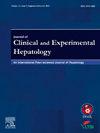慢性肝病患者GALAD、GAAP和ASAP检测肝细胞癌的比较
IF 3.2
Q2 GASTROENTEROLOGY & HEPATOLOGY
Journal of Clinical and Experimental Hepatology
Pub Date : 2025-06-11
DOI:10.1016/j.jceh.2025.102607
引用次数: 0
摘要
开发用于早期肝细胞癌(HCC)检测的生物标志物面板对于克服当前基于成像的监测策略的局限性至关重要。GALAD、GAAP和ASAP评分是基于性别、年龄、甲胎蛋白(AFP)、缺乏维生素K或拮抗剂ii诱导的蛋白和AFP- l3来估计HCC风险的公认算法。本研究旨在评估这些生物标志物和模型在慢性肝病(CLDs)患者HCC检测中的诊断性能。方法纳入529例患者,其中HCC患者193例,慢性肝炎患者223例,肝硬化患者113例。HCC的诊断依据标准影像学标准。利用受者工作特征曲线下面积(AUC)评估GALAD、GAAP和ASAP模型以及个体生物标志物的诊断性能,以识别各种病因的cld患者的HCC。结果GALAD、GAAP和ASAP模型检测CLD患者任何阶段HCC的auc(0.876-0.889)均优于单项生物标志物(0.741-0.842)。与单个生物标志物(0.654-0.710)相比,这些模型在早期HCC检测方面也显示出更高的准确性(0.825-0.889)。GAAP评分在CLD患者早期HCC检测中具有最佳准确性。此外,GAAP和ASAP模型在识别病毒性肝炎患者的所有阶段HCC方面表现最好,而GAAP和GALAD评分在非病毒性肝炎患者中最有效。检测HCC的最佳截止值为GALAD >;0.13, GAAP >;−0.64,ASAP >;−0.71,敏感性和特异性均在80%以上。结论GAAP模型在病毒亚组和非病毒亚组中对HCC和CLD具有良好的区分能力,在检测早期HCC方面优于其他模型。本文章由计算机程序翻译,如有差异,请以英文原文为准。

Comparison of the GALAD, GAAP, and ASAP Scores for Hepatocellular Carcinoma Detection in Patients With Chronic Liver Diseases
Background
Developing biomarker panels for early hepatocellular carcinoma (HCC) detection is crucial to overcome the limitations of current imaging-based surveillance strategies. The GALAD, GAAP, and ASAP scores are well-established algorithms for estimating the risk of HCC based on gender, age, alpha-fetoprotein (AFP), protein induced by vitamin K absence or antagonist-II, and AFP-L3. This study aimed to evaluate the diagnostic performance of these biomarkers and models in detecting HCC in patients with chronic liver diseases (CLDs).
Methods
The study enrolled 529 patients, comprising 193 with HCC, 223 with chronic hepatitis, and 113 with cirrhosis. HCC was diagnosed based on the standard imaging criteria. The diagnostic performance of the GALAD, GAAP, and ASAP models, along with individual biomarkers, was assessed using the area under the receiver operating characteristic curve (AUC) to identify HCC in patients with various etiologies of CLDs.
Results
The GALAD, GAAP, and ASAP models showed better AUCs (0.876–0.889) in detecting any stage of HCC in patients with CLD than individual biomarkers (0.741–0.842). These models also exhibited improved accuracy for early HCC detection (0.825–0.889) compared with individual biomarkers (0.654–0.710). The GAAP score achieved the best accuracy in detecting early HCC in patients with CLD. Furthermore, the GAAP and ASAP models performed best in identifying all-stage HCC in patients with viral hepatitis, while GAAP and GALAD scores were most effective in those with nonviral etiologies. The optimal cutoff values for detecting HCC were GALAD >0.13, GAAP > −0.64, and ASAP > −0.71, all with sensitivities and specificities above 80%.
Conclusions
The GAAP model demonstrated excellent discriminatory ability between HCC and CLD in both viral and nonviral subgroups and outperformed other models in detecting early-stage HCC.
求助全文
通过发布文献求助,成功后即可免费获取论文全文。
去求助
来源期刊

Journal of Clinical and Experimental Hepatology
GASTROENTEROLOGY & HEPATOLOGY-
CiteScore
4.90
自引率
16.70%
发文量
537
审稿时长
64 days
 求助内容:
求助内容: 应助结果提醒方式:
应助结果提醒方式:


